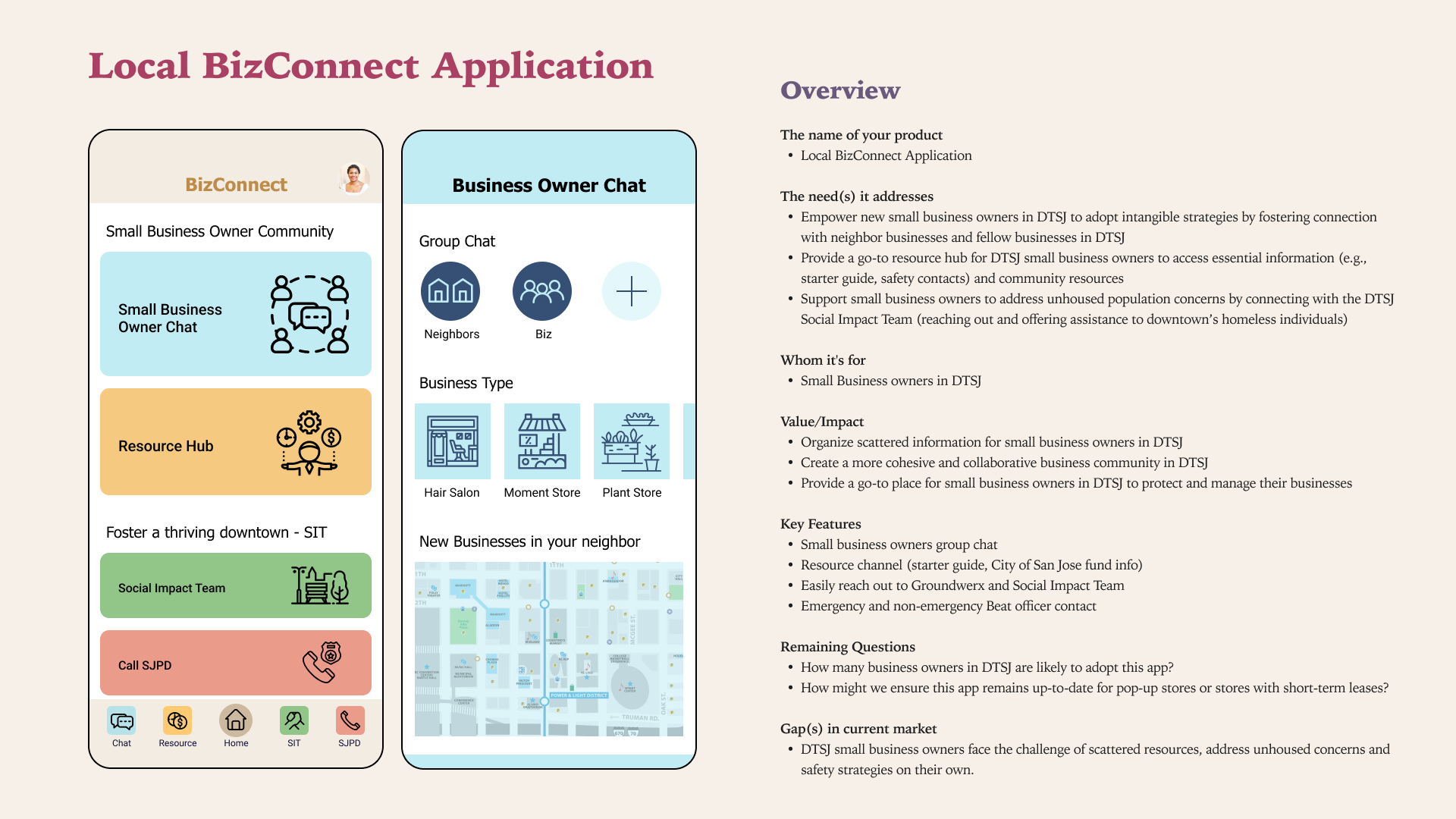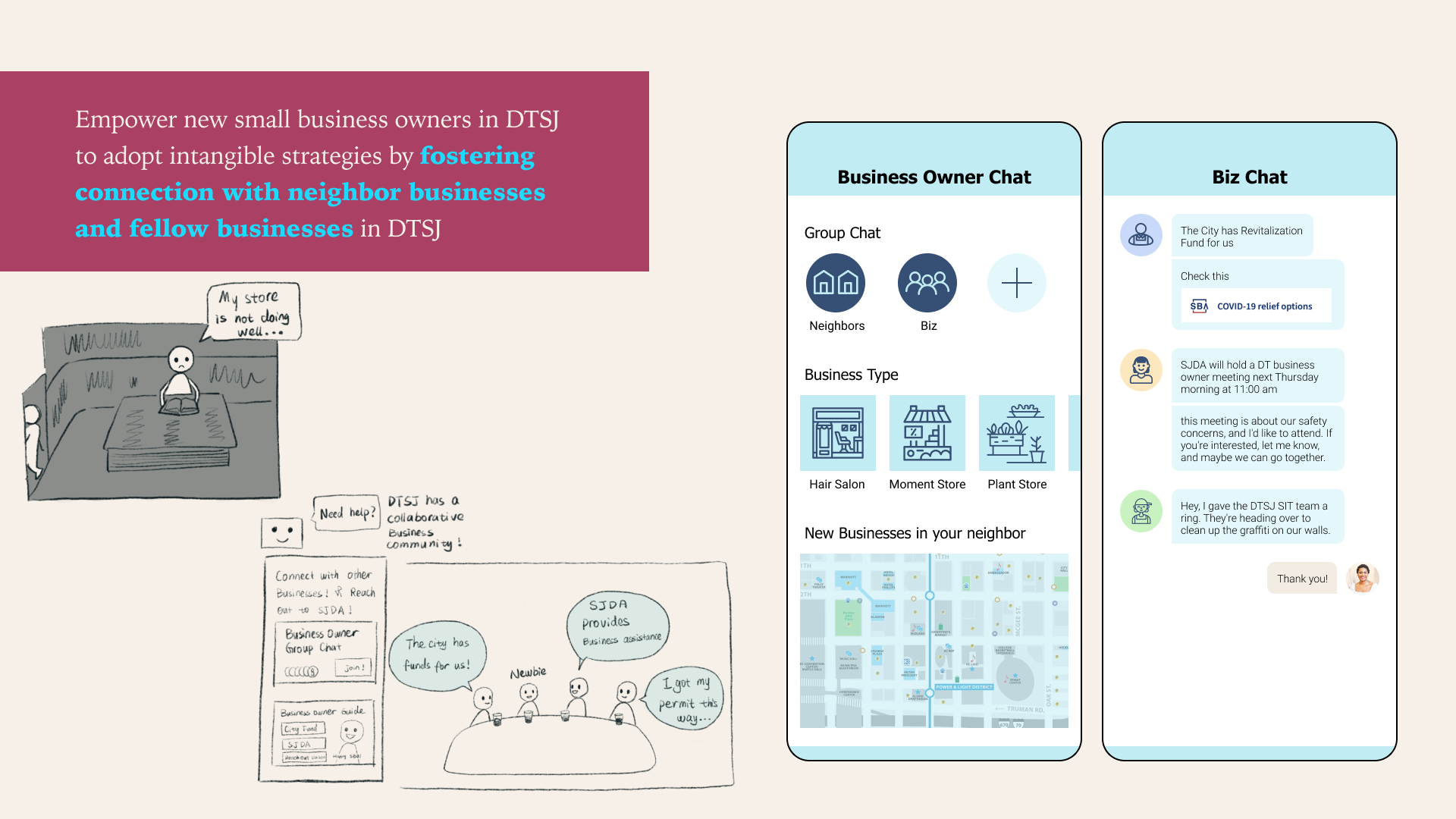Big Ideas for Small Businesses: Downtown San Jose
Design Research Methodologies | Final Project
The Challenge
Our goal was to research the perception of public safety from the perspective of small business owners in Downtown San Jose, CA. Using that research, we were to propose innovative design solutions to help meet the needs of our demographic.
The Team
I worked with fellow graduate students Yulie Dai and Taanya Gumidelli.
Why this topic?
We chose to research public safety from the perspective of Downtown San Jose small business owners for three reasons:
DTSJ has a lot of empty storefronts and blight.
DTSJ should feel like a “college town,” but students don’t tend to leave campus.
Bay Area downtowns are said to be in a post-pandemic decline.




Our Research
We conducted extensive primary and secondary research. This included:
8 Interviews with small business owners in downtown San Jose
4 Interviews with experts in safety, infrastructure, and local government
1 Public Safety, Finance & Strategic Support Committee meeting
4 Observations at downtown locations
2 city audit reports and committee analyses
1 Adobe Design for Good Workshop
6 local San Jose Newspaper articles
3 studies of other city’s safety initiatives
3 SWOT Analyses
The Process
We organized salient quotes and stories from our interviews into themes. These themes informed the development of our framework and our insights, and tensions that speak to the daily struggles of small business owners in downtown San Jose. All of this data informed the creation of our “How might we?” questions and our design guidelines.
We used our themes and tensions to plot factors contributing to perceptions of safety and risk onto the safety onion, which was our main framework for modeling our data and ideas. Things that made people feel safe or unsafe are plotted on the Y axis, and formal and informal safety solutions are plotted on the X axis.
Insights
We started this project laser-focused on juicy stories and big security solutions, however, most businesses only had one or two stories, and emphasized that safety wasn’t a major concern for their businesses. As we dug deeper, we discovered that Safety for small businesses in DTSJ is a layered issue, and there are a lot of intangibilities that contribute to a feeling of safety.
Our Solutions
We set out to use our design skills to propose solutions to our “How might we?” questions that would adhere to our design guidelines. Our 4 proposed solutions ran the gamut from an app to a marketing campaign.
Small Business Resource Ambassador - Not all business owners are tech savvy enough to search for all the resources that are available to them. A SBRA would hired by Groundwerx. Similar to SIT crew, they wear a shirt in a distinct color and their job is to talk directly to SBOs on a regular basis and help them out with any issues. This provides a direct human link to services for those that need it, and a strong community connection.
Local BizConnect App - Aimed at small business owners within the DTSJ PIB, this app serves to:
Create a more cohesive and collaborative business community in DTSJ
Organize scattered information for small business owners in DTSJ
Provide a reliable source for small business owners in DTSJ to protect their businesses
San Jose Hearts Campaign - This marketing campaign allows local residents and SBOs to have a hand in promoting their city to those who may not know what to do here. There are visual cues that DTSJ is safe, without the negative connotations of being directly associated with safety measures.
SBO|SJSU Partnership Course - A course offered at SJUS that acts as an intermediary between students and businesses. Students get course credits and real-world experience to work with businesses to solve their problems. Businesses get quick and cost-efficient solutions. Relationships between SBOs and students result in lasting connections between DTSJ and SJSU.
What I learned
My biggest takeaway from this course was that if you conduct enough research, and really analyze and synthesize your findings, then your solutions will seem magically obvious - not just to you, but to your audience as well. It was an honor to speak to a variety of business owners downtown, and I was surprised to learn that most people are happy to talk to you about themselves if you’re brave enough to ask.
Next steps
We received a lot of positive feedback on our results and presentation.
Our next steps are to talk with those we interviewed and get their opinions about our proposed solutions. Their feedback would be invaluable to implementation.
In implementing our proposed solutions, can we work only with vendors within the city of San Jose? It would feel appropriate to keep all possible implementation local.
If you’re interested in learning more, or in seeing our presentation or process document, you can email me here.




















